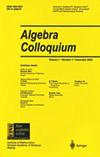Divisibility Properties of Power Matrices Associated with Arithmetic Functions on a Divisor Chain
IF 0.4
4区 数学
Q4 MATHEMATICS
引用次数: 0
Abstract
Let [Formula: see text], [Formula: see text] and [Formula: see text] be positive integers with[Formula: see text], [Formula: see text] be an integer-valued arithmetic function, and the set [Formula: see text] of [Formula: see text] distinct positive integers be a divisor chain such that [Formula: see text]. We first show that the matrix [Formula: see text] having [Formula: see text] evaluated at the [Formula: see text]th power [Formula: see text] of the greatest common divisor of [Formula: see text] and [Formula: see text] as its [Formula: see text]-entry divides the GCD matrix [Formula: see text] in the ring [Formula: see text] of [Formula: see text] matrices over integers if and only if [Formula: see text] and [Formula: see text] divides [Formula: see text] for any integer [Formula: see text] with [Formula: see text]. Consequently, we show that the matrix [Formula: see text] having [Formula: see text] evaluated at the [Formula: see text]th power [Formula: see text] of the least common multiple of [Formula: see text] and [Formula: see text] as its [Formula: see text]-entry divides the matrix [Formula: see text] in the ring [Formula: see text] if and only if [Formula: see text] and [Formula: see text] divides [Formula: see text] for any integer [Formula: see text] with[Formula: see text]. Finally, we prove that the matrix [Formula: see text] divides the matrix [Formula: see text] in the ring [Formula: see text] if and only if [Formula: see text] and [Formula: see text] for any integer [Formula: see text] with [Formula: see text]. Our results extend and strengthen the theorems of Hong obtained in 2008.除数链上算术函数幂矩阵的可整除性
设[公式:见文]、[公式:见文]和[公式:见文]为具有[公式:见文]的正整数,[公式:见文]为整数算术函数,且[公式:见文]的不同正整数集[公式:见文]为一个除数链,使得[公式:见文]。我们首先证明,矩阵[公式:见文]在[公式:见文]和[公式:见文]的[公式:见文]的最大公约数的[公式:见文]的[公式:见文]的[公式:见文]的[公式:见文]的[公式:见文]的[公式:见文]项的[公式:见文]的环中除[公式:见文]的GCD矩阵[公式:见文]当且仅当[公式:见文]和[公式:见文]除任意整数[公式:见文]的[公式:见文][公式:见文]。[公式:见文本]。因此,我们证明,矩阵[公式:见文]以[公式:见文]和[公式:见文]的最小公倍数[公式:见文]的[公式:见文]的[公式:见文]为其[公式:见文]条目的[公式:见文]除环中的矩阵[公式:见文]当且仅当[公式:见文]和[公式:见文]除任意整数[公式:见文]与[公式:见文]的[公式:见文]。最后,我们证明了矩阵[公式:见文]在环[公式:见文]中除矩阵[公式:见文]当且仅当[公式:见文]和[公式:见文]对任意整数[公式:见文]与[公式:见文]相除。我们的结果推广并加强了Hong在2008年得到的定理。
本文章由计算机程序翻译,如有差异,请以英文原文为准。
求助全文
约1分钟内获得全文
求助全文
来源期刊

Algebra Colloquium
数学-数学
CiteScore
0.60
自引率
0.00%
发文量
625
审稿时长
15.6 months
期刊介绍:
Algebra Colloquium is an international mathematical journal founded at the beginning of 1994. It is edited by the Academy of Mathematics & Systems Science, Chinese Academy of Sciences, jointly with Suzhou University, and published quarterly in English in every March, June, September and December. Algebra Colloquium carries original research articles of high level in the field of pure and applied algebra. Papers from related areas which have applications to algebra are also considered for publication. This journal aims to reflect the latest developments in algebra and promote international academic exchanges.
 求助内容:
求助内容: 应助结果提醒方式:
应助结果提醒方式:


